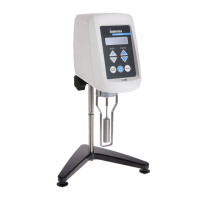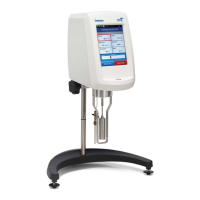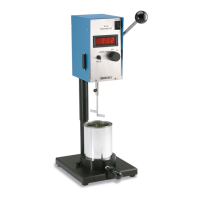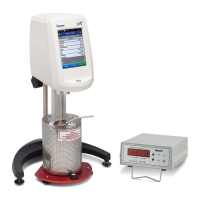Brookeld Engineering Labs., Inc. Page 4 Manual No. M/03-165-D0410
I. INTRODUCTION
The Brookeld DV-II+Pro Viscometer measures uid viscosity at given shear rates. Viscosity
is a measure of a uid’s resistance to ow. You will nd a detailed description of the science of
viscosity in the Brookeld publication “More Solutions to Sticky Problems” a copy of which
was included with your DV-II+Pro.
The DV-II+Pro offers exceptional versatility in modes of control allowing for traditional
standalone operation, automatic operation through programs downloaded from the PC or with
complete control by PC using Brookeld Rheocalc32 Software.
• The DV-II+Pro can be used as a traditional Brookeld viscometer for collection of single
speed viscosity data through the easy to use keypad; just select the spindle and speed and
read the value from the display. [see Section II, Getting Started]
• The Brookeld DVLoader Software can be used to program the DV-II+Pro to control
all aspects of the test and data collection without the need for the operator to monitor the
instrument; just start the program and return to the printed test data (printer is optional).
[see Section IV, DVLoader Software]
• The Brookeld Rheocalc32 Software will perform all control and data collection func
-
tions of the DV-II+Pro from the PC while also providing a platform for advanced data
collection and analysis. [see Section II.9, External Control]
In any of these modes of control, the DV-II+Pro will provide the best in viscosity measurement
and control.
The principal of operation of the DV-II+Pro is to drive a spindle (which is immersed in the
test uid) through a calibrated spring. The viscous drag of the uid against the spindle is
measured by the spring deection. Spring deection is measured with a rotary transducer. The
measurement range of a DV-II+Pro (in centipoise or milliPascal seconds) is determined by the
rotational speed of the spindle, the size and shape of the spindle, the container the spindle is
rotating in, and the full scale torque of the calibrated spring.
There are four basic spring torque series offered by Brookeld:
Spring Torque
Model dyne/cm milli Newton/m
LVDV-II+Pro 673.7 0.0673
RVDV-II+Pro 7,187.0 0.7187
HADV-II+Pro 14,374.0 1.4374
HBDV-II+Pro 57,496.0 5.7496
The higher the torque calibration, the higher the measurement range. The measurement range
for each torque calibration may be found in Appendix B.
All units of measurement are displayed according to either the CGS system or the SI system.
1. Viscosity appears in units of centipoise (shown as “cP”) or milliPascal-seconds (shown as
“mPa•s”) on the DV-II+Pro Viscometer display.
2. Shear Stress appears in units of dynes/square centimeter (“D/cm
2
”) or Newtons/square
meter (“N/m
2
”).
3. Shear Rate appears in units of reciprocal seconds (“1/SEC”).
4. Torque appears in units of dyne-centimeters or Newton-meters (shown as percent “%” in
both cases) on the DV-II+Pro Viscometer display.
Note: To change CGS to SI units on the display - see Section III.2.2.

